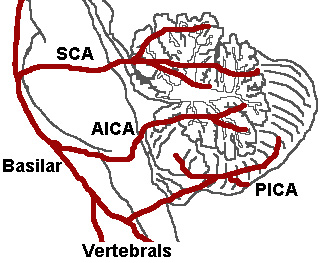Locked-In syndrome
| Locked-In syndrome | |
 | |
|---|---|
| Locked-In syndrome can be caused by stroke at the level of the basilar artery denying blood to the pons, among other causes.) | |
| ICD-10 | G46.3 |
| ICD-9 | 344.81 |
| MeSH | D011782 |
Editor-In-Chief: C. Michael Gibson, M.S., M.D. [1]
Synonyms and keywords: maladie de l'emmuré vivant, closest thing to being buried alive; Cerebromedullospinal Disconnection;[1] De-Efferented State; Pseudocoma;[2] and ventral pontine syndrome.
Overview
Locked-In syndrome is a condition in which a patient is aware and awake, but cannot move or communicate due to complete paralysis of nearly all voluntary muscles in the body. It is the result of a brain stem lesion in which the ventral part of the pons is damaged. The condition has been described as "the closest thing to being buried alive". In French, the common term is "maladie de l'emmuré vivant", literally translated as walled-in alive disease. [3]
Historical Perspective
The phrase "Locked-In syndrome" was created by Plum and Posner in 1966.[4][5]
Pathophysiology
Unlike persistent vegetative state, in which the upper portions of the brain are damaged and the lower portions are spared, locked-in syndrome is caused by damage to specific portions of the lower brain and brainstem with no damage to the upper brain.
Causes
Possible causes of locked-in syndrome include:
- Traumatic brain injury
- Diseases of the circulatory system
- Medication overdose
- Damage to nerve cells, particularly destruction of the myelin sheath, caused by disease (e.g. central pontine myelinolysis secondary to overly rapid correction of hyponatremia).
- A stroke or brain hemorrhage
Differentiating Locked-In Syndrome From Other Disorders
- Coma
- Unlike persistent vegetative state, in which the upper portions of the brain are damaged and the lower portions are spared, locked-in syndrome is caused by damage to specific portions of the lower brain and brainstem with no damage to the upper brain.
Natural History, Complications, Prognosis
It is extremely rare for any significant motor function to return. The majority of locked-in syndrome patients do not regain motor control, but devices are available to help patients communicate.
Diagnosis
Symptoms
Locked-in syndrome results in quadriplegia and inability to speak] in otherwise cognitively-intact individuals. Those with locked-in syndrome may be able to communicate with others by coding messages by blinking or moving their eyes, which are often not affected by the paralysis.
Patients who have locked-in syndrome are conscious and aware with no loss of cognitive function. They can sometimes retain proprioception and sensation throughout their body. Some patients may have the ability to move certain facial muscles, most often some or all of the extraocular eye muscles.
Treatment
There is no standard treatment for Locked-In syndrome, nor is there a cure. Stimulation of muscle reflexes with electrodes (Neuromuscular stimulation) has been known to help patients regain some muscle function. Other courses of treatment are often symptomatic.[6]
New direct brain interface mechanisms may provide future remedies.[7]
References
- ↑ Nordgren RE, Markesbery WR, Fukuda K, Reeves AG (1971). "Seven cases of cerebromedullospinal disconnection: the "locked-in" syndrome". Neurology. 21 (11): 1140–8. PMID 5166219.
- ↑ Flügel KA, Fuchs HH, Druschky KF (1977). "[The "locked-in" syndrome: pseudocoma in thrombosis of the basilar artery (author's transl)]". Dtsch. Med. Wochenschr. (in German). 102 (13): 465–70. PMID 844425.
- ↑ "Scientists seek to help 'locked-in' man speak", CNN, 14 December 2007
- ↑ "eMedicine - Stroke Motor Impairment : Article by Adam B Agranoff, MD". Retrieved 2007-11-29.
- ↑ Plum F. and Posner J.B. 1966. The diagnosis of stupor and coma. F.A. Davis Co. Philadelphia, Pennsylvania, USA. 197 pp.
- ↑ Template:NINDS
- ↑ Parker, I., "Reading Minds," The New Yorker, January 20, 2003, 52-63
Template:Cerebral palsy and other paralytic syndromes
Template:Lesions of spinal cord and brainstem
da:Locked-in-syndrom de:Locked-in-Syndrom it:Sindrome locked-in nl:Locked-in-syndroom